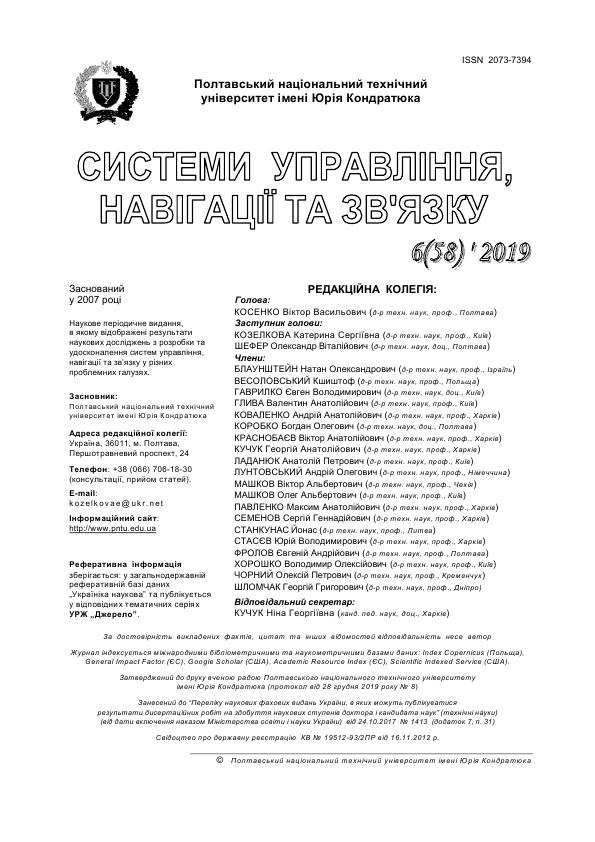SYNTHESIS OF INVENTORIES TO THE INTERFERENCE OF INFORMATION AND TELECOMMUNICATION SYSTEMS
DOI:
https://doi.org/10.26906/SUNZ.2019.6.115Keywords:
information and telecommunication system, invariance, error probability, adaptive obstacle, additive impediment, noise immunityAbstract
The article deals with the development of analytical algorithms of information and telecommunication systems formation that are invariant to the obstacle (additiveornon-aditiveone). The basic approaches to determine the class of obstacles for which an invariant system can be constructed are discussed and analyzed in detail. It is established that the invariance property of a feedback system guarantees the given probability of receiving information, but it does not guarantee a preset speed of information transmission. Studies have shown that invariance is achieved by reducing the noise immunity of additive noise. In a second-order phase-difference modulation system, the error probability is invariant to the signal frequency, but it is greater than the error rate in the system with phase-difference modulation at a constant signal frequency. As a result of the conducted researches it is established that the maximum of the undetected error does not depend on the characteristics of the interference, but is determined solely by the parameters of the correction code. The ways of improving the qualitative characteristics of information and telecommunication systems to ensure their invariance to the obstacle have been determined by analytical means, which is confirmed by simulation results and experimental dataDownloads
References
LeSheng Jin, Martin Kalina, Radko Mesiar, Surajit Borkotokey. Characterizations of the possibility-probability transformations and some applications. Information Sciences 477, (2019) pp. 281-290.
Katok A. and Hasselblatt B. Introduction to the Modern Theory of Dynamical Systems, Cambridge University Press, Cambridge, UK, 1995, pp.705-706.
F. Colonius and C. Kawan. Invariance entropy for control systems. SIAM J. Control Optim. 48, no. 3 (2009), 1701–1721.
G. Nair and R. Evans, Exponential stabilisability of finite-dimensional linear systems with limited data rates, Automatica, 39 (2004), pp. 585–593.
Cherneva G. D. Application of the theory of invariance for noise-resistance estimation of transportation information systems. International scientific journal "trans motauto world" Year III, Issue 2, (2018) pp. 70-72.
Erokhin V. F., Pelyshok E. V. Information Technology and Security no. 1(1) (2012), pp. 42-53.
C. Neipp et al., “An analysis of the classical Doppler effect,” 2003 Eur.J.Phys. 24, pp. 497-505.
V. C. Chen, F. Li, S.-S. Ho, and H. Wechsler. Micro-Doppler effect inradar: Phenomenon, model, and simulation study.IEEE Transactions onAerospace and Electronic Systems, 42(1) (2006) pp. 2-19.
Steklov V.K. Teoriya elektrychnogo zv'yazku: pidruchnyk / V.K. Steklov, L.N. Berkman. – K.:Tehnika, 2006. – P. 548.
Smirnov V.S, Samkov A.V., T.V. BulgachOrganization invariant intensive - converting systems to the prediction for. hardware telecommunications equipment // Naukova- virobnichy magazine Admіnіstratsії zv'yazku that radіochastot. Ukraine "phone reception". – 2009. – Vip. 4 (88) . – S. 47 - 51.
Tolubko, V. B. Formuvannya bagatopozycijnogo sygnalu texnologij 5G na bazi fazoriznycevoyi modulyaciyi vysokogo poryadku / V. B. Tolubko, L. N. Berkman, S. V. Kozelkov // Zv'yazok. – 2016. – no. 4. – pp. 5–7.
M. Feldman. Theoretical analysis and comparison of the Hilbert transform decomposition methods.Mechanical Systems and Signal Processing. 22 (3),(2008) pp. 509-519.
Кучук Г.А. Метод мінімізації середньої затримки пакетів у віртуальних з’єднаннях мережі підтримки хмарного сервісу / Г.А. Кучук, А.А. Коваленко, Н.В. Лукова-Чуйко // Системи управління, навігації та зв’язку. – Полтава. ПНТУ, 2017. – Вип. 2(42). – С. 117-120.
Кучук Г. А. Метод синтезу інформаційної структури зв’язного фрагменту корпоративної мультисервісної мережі / Г. А. Кучук // Збірник наукових праць Харківського університету Повітряних сил. – 2013. – No 2(35). – С. 97-102.
Wim van Drongelen. Signal Processing for Neuroscientists (Second Edition) 2018, pp. 251-288.
Kapoor, A., Grauman, K., Urtasun, R. and Darrell, T. Gaussian Processes for Object Categorization, 2010. International Journal of Computer Vision, Vol 88(2), pp. 169-188.




